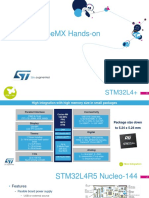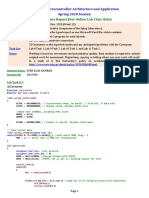0% found this document useful (0 votes)
8 views6 pages2301EC56 Uc STM32
The document outlines an experiment conducted by Saksham Srivastava to blink an LED on the STM32F103RB Nucleo board using embedded C programming and the HAL library. It details the necessary hardware and software, the core functions of the HAL library, and the logic for blinking the LED. The experiment successfully demonstrated the LED blinking with a 500ms interval, confirming the correct implementation of the HAL functions.
Uploaded by
Abhijat JhaCopyright
© © All Rights Reserved
We take content rights seriously. If you suspect this is your content, claim it here.
Available Formats
Download as DOCX, PDF, TXT or read online on Scribd
0% found this document useful (0 votes)
8 views6 pages2301EC56 Uc STM32
The document outlines an experiment conducted by Saksham Srivastava to blink an LED on the STM32F103RB Nucleo board using embedded C programming and the HAL library. It details the necessary hardware and software, the core functions of the HAL library, and the logic for blinking the LED. The experiment successfully demonstrated the LED blinking with a 500ms interval, confirming the correct implementation of the HAL functions.
Uploaded by
Abhijat JhaCopyright
© © All Rights Reserved
We take content rights seriously. If you suspect this is your content, claim it here.
Available Formats
Download as DOCX, PDF, TXT or read online on Scribd
/ 6





























































































